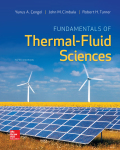
(a)
The temperature on the two sides of the circuit board.
(a)
Explanation of Solution
Given:
Thickness of the board is 0.3 cm.
The height of the board is 12 cm.
The length of the board is 18 cm.
Number of logic chips is 80.
Heat dissipated by each chip is
The thermal conductivity of the board is
Temperature of the medium is
The heat transfer coefficient is
Thickness of the aluminum plate is 0.2 cm.
The height of the aluminum plate is 12 cm.
The length of the aluminum plate is 18 cm.
The thermal conductivity of the aluminum plate is
Number of aluminum fins is 864.
Length of the fins is 2 cm.
Diameter of the fin is 0.25 cm.
Thickness of the epoxy adhesive is 0.02 cm.
Thermal conductivity of the epoxy is
Calculation:
The total heat transfer rate by the chips is,
The total thermal resistance is,
Calculate the temperature on the two sides of the board.
Similarly,
Thus, the temperature on the two sides of the circuit board is
(b)
The temperature on the two sides of the circuit board after the aluminum plate is attached.
(b)
Explanation of Solution
Calculation:
Calculate the value of m.
The efficiency of the fin is,
Calculate the total area with fins,
The total thermal resistance is,
Calculate the temperature on the two sides of the board.
Similarly,
Thus, the temperature on the two side of the circuit board after the aluminum plate is attached is
Want to see more full solutions like this?
Chapter 17 Solutions
EBK FUNDAMENTALS OF THERMAL-FLUID SCIEN
 Elements Of ElectromagneticsMechanical EngineeringISBN:9780190698614Author:Sadiku, Matthew N. O.Publisher:Oxford University Press
Elements Of ElectromagneticsMechanical EngineeringISBN:9780190698614Author:Sadiku, Matthew N. O.Publisher:Oxford University Press Mechanics of Materials (10th Edition)Mechanical EngineeringISBN:9780134319650Author:Russell C. HibbelerPublisher:PEARSON
Mechanics of Materials (10th Edition)Mechanical EngineeringISBN:9780134319650Author:Russell C. HibbelerPublisher:PEARSON Thermodynamics: An Engineering ApproachMechanical EngineeringISBN:9781259822674Author:Yunus A. Cengel Dr., Michael A. BolesPublisher:McGraw-Hill Education
Thermodynamics: An Engineering ApproachMechanical EngineeringISBN:9781259822674Author:Yunus A. Cengel Dr., Michael A. BolesPublisher:McGraw-Hill Education Control Systems EngineeringMechanical EngineeringISBN:9781118170519Author:Norman S. NisePublisher:WILEY
Control Systems EngineeringMechanical EngineeringISBN:9781118170519Author:Norman S. NisePublisher:WILEY Mechanics of Materials (MindTap Course List)Mechanical EngineeringISBN:9781337093347Author:Barry J. Goodno, James M. GerePublisher:Cengage Learning
Mechanics of Materials (MindTap Course List)Mechanical EngineeringISBN:9781337093347Author:Barry J. Goodno, James M. GerePublisher:Cengage Learning Engineering Mechanics: StaticsMechanical EngineeringISBN:9781118807330Author:James L. Meriam, L. G. Kraige, J. N. BoltonPublisher:WILEY
Engineering Mechanics: StaticsMechanical EngineeringISBN:9781118807330Author:James L. Meriam, L. G. Kraige, J. N. BoltonPublisher:WILEY





